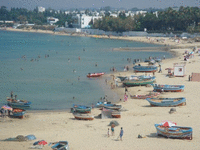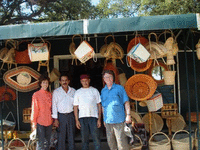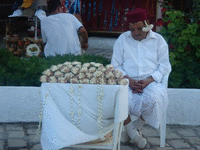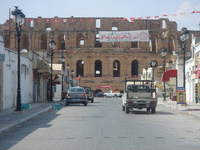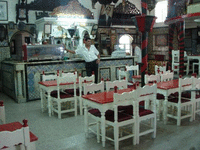This is a friendly Mediterranean country where Arab culture meets European sunbathing at the very popular Hammamet and Sousse resorts.
In a North African country known for its 60 million olive trees, you might not expect 1,300-kilometers of shoreline along the Mediterranean Sea. Yet Tunisia’s history as a beach resort dates to the Phoenicians, who founded the seafaring colony of Carthage near the modern-day capital of Tunis in 814BC.
Within a half-hour of the international airport, families can reach the fully developed east coast beach town of Hammamet, or fly direct to Sousse and farther south to Monastir and the fishing village of Mahdia. Tunisia’s newer, less developed north coast resorts cater to the capital’s prosperous population, who commute to the pretty port of Bizerte and the quieter, wooded Tabarka on summer weekends.
Some vacationers prefer the exquisite isolation of the highly developed island of Djerba, with its fine sand beaches, shallow water and leaning palms. This popular vacation isle off Tunisia’s south coast has whitewashed Mediterranean Arab villages, domed houses and historic mosques to add cultural interest. Connected by a land bridge, Djerba is only one hour from the Tunisian desert for families who want to explore the stark sand dunes made famous by the three “Star Wars” prequels. The vast sands are best seen in non-summer months, so our family concentrated instead on the northern and eastern beach areas whose own long, intriguing history reflects Tunisia’s multicultural past.
Because Tunisia is a fairly liberal Arab country that learned European ways during the long period of French colonization, its successful beach resorts cater to Western taste and customs in attire, cuisine and nightlife. Visitors will be able to sunbathe topless, replenish their l’Oreal sunblock and have croissants and café au lait for breakfast, meanwhile sharing a rich culture influenced by the occupying armies of Rome, Byzantium, Arabia, Turkey, and France.
Hammamet & Surrounds
Just 62 kms south of Tunis, the world-class resort development of Hammamet rims 25 kms of beach on the east coast of the Cap Bon Peninsula. A long popular Mediterranean resort — its fitting name is derived from the Arabic hammam or bath — there’s not much more to do than enjoy the sun and stroll the sand. Hammamet has maintained its small town charm, however, by keeping a well preserved medina of tourist shops and a restored fortress safely within a pedestrian only zone.
Families spend the cool sunset hours strolling by the marina, pushing babychairs through the tangle of foreign press newsstands and postcard stalls, and admiring the classic whitewashed Mediterranean architecture. Even the condo developments owned by wealthy Tunisians and French retirees are unobtrusive, lowrise stucco units draped in bougainvillea. Hammamet celebrates at the Orange Festival held each April, when orange blossoms are harvested for their oil; and at the summer-long Tunisian Summer Festival with arts performances here and in Carthage.
Most of Hammamet’s seafront family resorts are outside the town, and there’s a bright pink tourist trolley that shuttles between Hammamet Ville (the village), Yasmine Hammamet (an upscale, purpose built community whose golf course and lifestyle mall compete with the best in Florida), the prosperous ceramics center of Nabeul, and the Aquapolis Waterpark. Those on a tighter budget may prefer one of the simple, whitewashed, two-cots-in-a-room style pensiones that cling to the walls of the fortress. In any case, it’s easy to park the car and return to the village for a day of cafes, shopping, and strolling with the wealthy Arab and European crowd.
In Hammamet Ville, Le Fort (or The Citadel) is certainly worth a visit. Known as a borj or fortified country house during the 9th century, this beautiful walled castle was enlarged under the Ottomans, then sacked by the Knights of Malta during a clever surprise raid in 1602. All ages will enjoy the view from its ramparts, which were restored and are maintained by the local village. Bypass the Citadel’s small café and just outside you’ll find everyone’s favorite beach bum bar, the Sidi Bouhdid. Relax outdoors under their thatched canopy with a mint tea, and be sure to visit the interior, where woven cushions invite guests to recline on the stucco banquettes. Traditional Tunisian costumes and regalia bestowed on tiny bridesmaids and boys awaiting circumcision are displayed.
Yasmine Hammamet offers a fun outing because of its new 870-yacht marina and fancy, international style housing and commercial development. The Port Yasmine outdoor mall is a good evening diversion for inquisitive and acquisitive teens. Nearby is the small Carthageland fun park, where rides and a midway are themed with the elephants that Hannibal used to defend the original ancient city. The whole family will enjoy an air-conditioned break at the multimedia show entitled “Tunisia Odysee,” which chronicles 3,000 years of the country’s history through slides, animation, films, music and special effects.
Sousse & Surrounds
Sousse (or Soussa), historically the port of Hannibal, is another of the country’s popular resorts. Just 75 minutes by car from Tunis, it shares the nearby airport facility with the resort of Monastir and both are packed with mass market tourists arriving on charter flights. The lure here is a beautiful beach next to a medina surrounded by the thick ramparts of a kasbah, in which families can visit the 9th-century Ribat, a fortress built to house Muslim monks who served as guardians for the coast. The Ribat minaret was designed as a lookout and outfitted with beacons that could communicate with other ribats, such as the one at Monastir, along the coast.
A designated UNESCO World Heritage Site, Sousse was founded by the Phoenicians in the 9th century BC. The restored Arabic Medina features the Great Mosque dating to the 9th century AD, an archeological museum, Museum of Popular Arts, a maze of souks or market shops, and the Dar Essid, a traditional home that has been restored and opened to public view. Don’t miss the Koubba, an unsual Medieval building with an ornate zigzag dome; and the Sofra Cistern, a 9th century underground water tank.
There are some hotels within the medina but most are found along a seemingly endless beachfront drive, Bou Jaafar, that passes kilometers of beautiful gold sand beaches. Of the dozens of large open-air restaurants, the Casa Del Gelato, a huge indoor/outdoor ice cream parlor, coffeeshop and late night bar, is noteworthy because it shows classic movies at night on its outdoor screen.
The prettiest, if totally faux, part of Sousse is the purpose built development at Port El Kantaoui. As on many Greek islands, dozens of shops and cafés line the cobblestone streets of a pedestrian village that is surrounded by a 340-berth marina on one side, and hundreds of elegant country condos on the other fronts. The usual warm weather pursuits are all available: the El Kantaoui Golf Course has two 18-hole championship courses; a diving center runs snorkel and scuba excursions; there is gambling at the Casino Caraibes.
From Hammamet or Sousse, families can make day trips to the stunning Roman coliseum at El Jem, a pleasant town with an excellent archeological museum exhibiting some of the world’s best Roman- era mosaics. Evening symphonic concerts are given at the restored coliseum throughout the month of August. Another important daytrip is to the holy Islamic city of Kairouan, known for its 7th century mosque and long tradition of rug weaving. Be sure to hire a guide to fully appreciate this town, itself a UNESCO World Heritage Site, and make the most of your visit.
Nabeul is a busy industrial city with an illustrious tradition of ceramics, pottery and tile making. This is where the personalized dishware seen at so many Tunisian hotels and restaurants comes from. The Societe Kerkeni shop (72 221 808) at 121 Av. Habib Thameur has a wide variety of traditional and stylish contemporary wares featured over two large floors, and children especially will enjoy watching the craftsmen at work shaping, throwing and painting the pieces.
For more local excursions, families can visit the village of Hergla where esparto grass weaving and fishing are the primary occupations; the traditional rural village of Takrouna; the Andalusian or Moorish-inspired town of Zaghouan; and Espace Ken, a purpose built “village” and handcrafts center with artisan demonstrations, costumed re-enactors, and a swimming pool open to visitors.
Family-Friendly Lodging in the Tunisian Sense
Many major European and North African companies have invested in building resorts at these beach areas that are often newer than the locally owned hotels. Options in the four-star and five-star categories (hotels are inspected and rated by the government), range from the deluxe Tunisian Abou Nawas brand; to an all-inclusive Club Med; or the Spanish companies Riu, Iberostar or Melia; the Italian Vincci or the French Coralia Club resorts. While all hotels have some children’s facilities and babysitting available, few have an organized and supervised children’s program for younger children.
Resort stays are often packaged with airfare deals from France, Germany, Italy and Spain. (North Americans can look for great packages on Karthago Airlines and Nouvelles Frontieres, who fly to Tunis from Montreal, Quebec, Canada.)
The luxe Tunisian chain, Hasdrubal Thalassa & Spa, has developed all-suite resorts with seafront spas at Port Kantaoui near Sousse, in Yasmine Hammamet, and on the island of Djerba off Tunisia’s southern coast. They present an opulent and pricey (but good value relative to services) choice for families.
The nouvelle Tunisian décor is comprised of gilded coffered ceilings, glistening chandeliers, original international artwork, oriental rugs, and extra spacious rooms with multi-colored mosaics and tile work, four-poster beds, heavy drapery and rich upholstery. Hasdrubal’s interpretation of traditional Arab hospitality includes business facilities worthy of any convention center, ubiquitous fresh flowers, ornamental columns throughout, a professional, highly trained and multilingual staff, and details like waiters in admiralty uniforms at the poolside barbecue.
Hasdrubal has invested heavily in the layout, style and state-of-the-art aqua facilities at their thalassotherapy spas, where beauty treatments and medicinal cures prescribed by staff doctors are based on sea water therapies. Immaculate spa facilities typically include hydromassage and algotherapy cabins; affusion, jet, and underwater showers; a Turkish hammam or steam bath; massage, fitness and relaxation rooms; aromatherapy suites; beauty and hair salons; and a sea-water indoor swimming pool. Although thalassotherapy is the main attraction for 70% of resort guests, according to management, the variety of outdoor swimming pools, tennis and nearby golf facilities to be expected at five-star places is here as well.
Wellness and spa vacations are very popular with Europeans and, more recently, wealthy families from the region. There is no children’s program at the Hasdrubal resorts, but private babysitting is available for parents who want to take advantage of the spa, and some treatments are available to older teens.
Prices vary at each resort according to season and location. A double suite ranges in price from Euros 210-280/N plus Euros 14 for a babycot in the room; a two-room Ambassador suite sleeping four costs from Euros 375-600/N, all including an appropriately regal breakfast. Tunisia’s Mediterranean coast has fair weather year-round, so rates are highest in the busy August, winter, and Easter holiday periods.
{C}{C}
Bizerte, Tabarka & North Coast Resort Areas
The picturesque north coast resort of Bizerte, within 30 kms of Tunis, has a long legacy of foreign influence because the French had a strategic military base there until 1961 – reluctantly relinquished after a bloody five-year post-independence battle. Today, retired French veterans and their families are moving into the many new aparthotels that have risen along its coast. Bizerte has several ports wrapped around a saltwater lake connected to the Mediterranean by a canal dating back to the Roman era. Near the factories dominating one part of the skyline are the huge tankers of a commercial port; on the other hand is a superbly restored kasbah framing a picture-perfect fishing port — despoiled by waste – that is gleefully used for swimming by the local boys.
Don’t be discouraged; the regional government has big plans for this city of 120,00 residents that welcomes more than 350,000 guests on an average summer weekend. There’s a very long and beautiful gold sand beach just a few kilometers west of the port with some nice resort hotels. Bizerte’s fortified Medina is lined with the classic whitewashed walls of courtyard homes in the Al-Andalus style, and the town’s wildly successful daily fish market and produce market are well worth a visit. The Hotel Bizerta (216 72 43-6966) has a privileged place within a large garden set back from the beach. Its 100 spacious rooms are comfortable and sleep three; connecting rooms are available where kids 2-6 years pay 50% of the adult rate, and children 7-15 years pay 70% of the daily room and board. The hotel’s large pool is surrounded by chaises and a shaded restaurant draped in bougainvillea. If you spend a few days, consider a snorkeling expedition with one of the local outfitters.
Bizerte’s development has lagged behind that of another popular north coast beach at pretty Tabarka, a base for exploring some of the north’s Roman ruins and Ain Draham, a forested hill town that Tunisians like to compare to Switzerland. Tabarka is known for its annual Jazz Festival in July; les Aiguilles or the Needles, the sharp pronged rocks that mark one end of its crescent cove; and anomalies like the Café Andalous, an old Moorish style restaurant festooned with tiles and carved woodwork. The small tourist area has an outdoor bazaar featuring handmade crafts of seashells and bark, the local product, but we found, even with Tabarka’s hilltop Genoese castle (closed to the public), Bizerte had much more to offer.
Nonetheless, many consider Tabarka’s sand-fringed shore the next destination for budget-minded international chain resorts, perhaps because its proximity to Algeria, just 40 kms away, makes it a popular driving vacation for Algerian families.
One of the more pleasant coastal resorts is Hotel Dar Ismail in the Zone Touristique (216 78 67 01 88). The lobby, vibrating with strong gold and red colors that lend an Oriental feel, overlooks a large pool and smaller kiddie pool in a landscaped area.
For more information about the country prior to departure, contact the offices of Tunisian National Tourism in the US (202/466-2546 in Washington DC), Canada (514/397 11 82 in Montreal) or Great Britain (171 22 45 598 in London) or visit www.tourismtunisia.com.
Dear Reader: This page may contain affiliate links which may earn a commission if you click through and make a purchase. Our independent journalism is not influenced by any advertiser or commercial initiative unless it is clearly marked as sponsored content. As travel products change, please be sure to reconfirm all details and stay up to date with current events to ensure a safe and successful trip.
